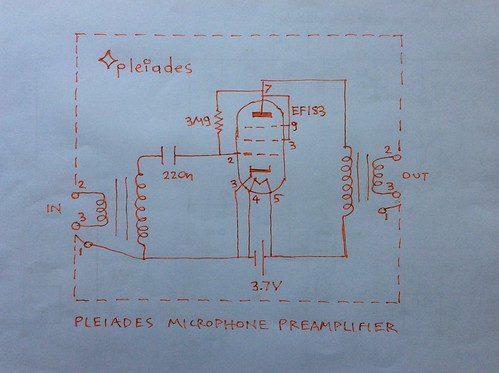The first stage is a bipolar transistor.
What could be simpler?
By examining the service manual of 4000, 4200, 4400 if observation is correct the mic input impedance is said to be 2KΩ. There is a 3.9KΩ resistor in parallel with the input.
Line input or phono input is made by connecting to the mic input a 47KΩ or 1MΩ series resistor respectively.
This seems to be a brilliant and simple idea. This is by the way the way volume is controlled on the Pleiades 2N3053 one transistor power amplifier. Just a variable series resistor. Transistors seem to like a series input resistor. After all they are current input devices. Like low inductance transformers fed by 200Ω impedance microphones (see Pleiades filters), like recording heads fed by a large output impedance for constant current drive.
So far the brilliant Uher 4200 was tested by recording with an inexpensive 667ohm AKG pressure microphone, see today's post. Wow.
Perhaps the only sound so far surpassing this sound quality is the Pleiades V6 mic booster amp monitored in real time, (live, without recording). Note, the Ferrograoh series 6 electron tube reel to reel recorder may record or playback even better. But it is not lightweight portable or battery powered. The Ferrograph has not been tried yet with close miking or a Pleiades booster mic preamp.
So how would the brilliant Uher 4200 sound when recording a top quality low noise signal by connecting its mic input to Pleiades V6 and a world class moving coil microphone connected to the V6's transformer input?

The order of 2000Ω Uher input impedance at its mic in is good news. Would the 2DV4 Nuvistor electron tube (which has not yet been tried on the V6 schematic) powered by just 1.3V for both heaters and plate do the trick of great sound with lease noise? There are too many other portions, see for example the 1H4 electron tubes powered by 1.3V and 9V with grid at space potential. Attention to always using a correct fuse in series with a battery for safety.
Caution is possibly needed as the rec level control on the Uher is after the second transistor stage. The external front end shouod not have too much gain. Later note: by closer looking at the schematic just 3 transistors are form mic to recording head. Just one from mic to rec level control. It should be fine.
If a booster mic amp is not connected or needed how would the sound be with just say a Sennheiser MD211 or MD441 etc? If the sound is bass heavy due to effects including phycho acoustic ones a Pleiades (L,R) passive filter can be inserted between the two.
No comments:
Post a Comment